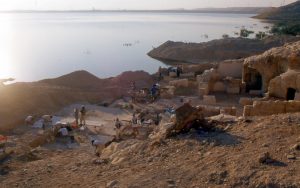Consolidation and protection
The solution identified to protect the structures before flooding was to:
– consolidate the structures to their support, where necessary;
– cover them with a layer of hydraulic mortar about 5 cm thick (mortar composed of Lafarge hydraulic lime, slaked lime, brick dust and stone dust);
– rebury the areas under a layer of earth, gravel and pebbles, thickness ranging from 50 cm to a meter.
Before applying the surface protection layers, accumulations of earth and roots along the edges and in areas with lacunae were mechanically removed; unstable parts and edges were consolidated with mortar based on hydraulic lime and brick dust.
A layer of lime wash was brushed on in direct contact with the consolidated and cleaned surface, in order to isolate the original surface from the subsequent protective layer so that the latter could be removed more easily in the future.
Once the lime wash was dry, a 5 cm thick protective layer was added; this was hydraulic mortar composed of Lafarge hydraulic lime, slaked lime, brick dust and stone powder. This layer was worked at length to reach perfect adhesion with the underlying surfaces.
The hydraulic mortar layer will protect the original from the water’s mechanical action and act as a sacrificial layer. At the same time, its hydraulic nature will enable it to harden further in contact with moisture and progressively improve its mechanical resistance.
In this way, every encounter with the environment will occur on the added layer and not directly on the original. The choice of hydraulic mortar was influenced by its high resistance, mechanical and hydraulic properties, durability and total compatibility with the original surfaces. This idea of applying a layer of hydraulic mortar derives from analysis of many cases of “scialbatura” or plastering of frescoes and pavements for various reasons: health (epidemics), religious (censorship) or stylistic (renewal of interiors): every time we removed these lime-based layers, we found the underlying surfaces in perfect condition.
A “modern” verification of the method’s efficiency came from analysing the results of a similar covering applied in the late 1970s on 300 m2 of mosaics in the Roman site of Nora, on the south coast of Sardinia. Beneath the protective layer, once removed, the mosaics appeared to be in the same condition as twenty-five years before.





















